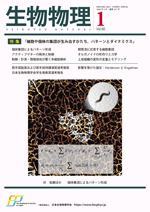
- |<
- <
- 1
- >
- >|
-
Masashi SONOYAMA2020Volume 60Issue 1 Pages 001
Published: 2020
Released on J-STAGE: January 25, 2020
JOURNAL FREE ACCESSDownload PDF (504K)
-
Keiichi INOUE, Madoka SUZUKI, Tsuyoshi HIRASHIMA2020Volume 60Issue 1 Pages 005
Published: 2020
Released on J-STAGE: January 25, 2020
JOURNAL FREE ACCESSDownload PDF (543K) -
Takuma SUGI, Hiroshi ITO, Ken H. NAGAI2020Volume 60Issue 1 Pages 006-012
Published: 2020
Released on J-STAGE: January 25, 2020
JOURNAL FREE ACCESSActive matter refers to systems composed of elements self-propelled by the dissipation of energy, in which dynamical patterns emerge as is in flocks of birds and schools of fish. Some of researchers on the active matter physics seek to identify unified descriptions of such collective motions through interdisciplinary approaches by biologists and physicists. Owing to such collaborations, experimental studies pertaining to the active matter physics are developing recently, which allows us to verify the proposed mathematical models. Here, we review experimental systems of active matter physics, focusing on animal collectives.
View full abstractDownload PDF (3477K) -
Yusuke T. MAEDA, Kazusa BEPPU2020Volume 60Issue 1 Pages 013-018
Published: 2020
Released on J-STAGE: January 25, 2020
JOURNAL FREE ACCESSCollective motion organized by autonomous motile elements is ubiquitous across scales, from motor proteins, flagellated sperms, to animals and fishes. Such motile materials are called active matter, and collective dynamics of active matter attracts broad interest from physics and biology due to their potential in exploiting universal feature of ordered structure and dynamics in biological systems. Here, we describe collective ordered phase of bacterial vortices under confinement with designed geometries. The transition of ordered vortices can be controlled by geometric rule derived from Vicsek-style model. This finding may bring design principle of collective ordered phase of confined self-propelled particles.
View full abstractDownload PDF (2551K) -
Masaya HAGIWARA2020Volume 60Issue 1 Pages 019-024
Published: 2020
Released on J-STAGE: January 25, 2020
JOURNAL FREE ACCESSA multicellular organization is a complex system resulting from the orchestrating individual cellular migration to form a specific pattern. To elucidate the system, it is important to exert not only biological technologies but also control, sensing and information technologies. Controlling culture environments can enhance the repeatability of in vitro experimental result and add perturbation to validate the hypothesized theory. Large scale imaging at high resolution imaging provides comprehensive insight, and information systems lead us effective analysis from the obtained in vitro data. Once those technologies are well synchronized, we can open-up new insight.
View full abstractDownload PDF (6379K) -
Ryo SUDO2020Volume 60Issue 1 Pages 025-030
Published: 2020
Released on J-STAGE: January 25, 2020
JOURNAL FREE ACCESSBiomechanical stimuli derived by interstitial flow regulate morphogenesis of multicellular systems including both physiological and pathological cells. For example, hepatocytes construct three-dimensional structures in directional interstitial flow conditions. Protrusions of tumor cells are also induced by interstitial flow, resulting in enhanced tumor cell invasion. Interestingly, the direction of tumor cell invasion in response to directional interstitial flow differs depending on the type of tumor cells. Furthermore, endothelial cells form capillary networks against the direction of interstitial flow in a magnitude-dependent manner. Taken together, interstitial flow is an important factor for regulating morphogenesis of multicellular systems.
View full abstractDownload PDF (6090K) -
Satoru OKUDA2020Volume 60Issue 1 Pages 031-036
Published: 2020
Released on J-STAGE: January 25, 2020
JOURNAL FREE ACCESSOrganoid is a tissue that recapitulates three-dimensional structures of organs in vitro, whose development owes to self-organizing properties of multi-cellular system. Although key molecular factors for each developmental process have been revealed, it is still difficult to explain how organoids are formed by cell autonomy. Here I review our recent studies of optic-cup organoids. The studies revealed two modes of myosin-dependent epithelial deformations; i.e., apical relaxation and lateral constriction, and emphasized the importance of epithelial thickness regulation. Moreover, we found the mechanical feedback mechanism from macroscopic tissue deformations to individual cell behaviors that modulates the entire tissue shape.
View full abstractDownload PDF (8786K) -
Shuji ISHIHARA, Kaoru SUGIMURA2020Volume 60Issue 1 Pages 037-043
Published: 2020
Released on J-STAGE: January 25, 2020
JOURNAL FREE ACCESSEmbryonic development involves important shape and volume transformations of tissues or organs that occur as a result of different cellular processes, such as cell division, shape change, rearrangement, and apoptosis. These processes are tightly linked with the mechanical forces exerted by cells. Here, we present methods to quantify tissue deformation and mechanical forces. Moreover, we propose a continuum model to decipher tissue mechanics based on the mechanical nature of cells, which correlates with the quantified deformation and forces. These will provide useful tools for understanding the mechanical control of morphogenesis.
View full abstractDownload PDF (3516K)
-
Yuki SUDO, Takeshi MURATA2020Volume 60Issue 1 Pages 045-046
Published: 2020
Released on J-STAGE: January 25, 2020
JOURNAL FREE ACCESSDownload PDF (1832K) -
Yuki SUDO, Noriyuki KODERA, Chie HOSOKAWA2020Volume 60Issue 1 Pages 047-048
Published: 2020
Released on J-STAGE: January 25, 2020
JOURNAL FREE ACCESSDownload PDF (2381K) -
Mikio KATAOKA2020Volume 60Issue 1 Pages 049-050
Published: 2020
Released on J-STAGE: January 25, 2020
JOURNAL FREE ACCESSDownload PDF (2037K)
-
[in Japanese], [in Japanese], [in Japanese]2020Volume 60Issue 1 Pages 051-052
Published: 2020
Released on J-STAGE: January 25, 2020
JOURNAL FREE ACCESSDownload PDF (4583K)
-
[in Japanese]2020Volume 60Issue 1 Pages 053-054
Published: 2020
Released on J-STAGE: January 25, 2020
JOURNAL FREE ACCESSDownload PDF (1244K)
-
[in Japanese]2020Volume 60Issue 1 Pages 055-056
Published: 2020
Released on J-STAGE: January 25, 2020
JOURNAL FREE ACCESSDownload PDF (1361K)
-
2020Volume 60Issue 1 Pages 044
Published: 2020
Released on J-STAGE: January 25, 2020
JOURNAL FREE ACCESSDownload PDF (438K)
- |<
- <
- 1
- >
- >|